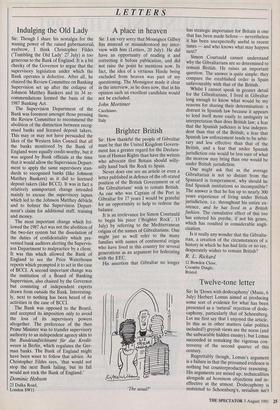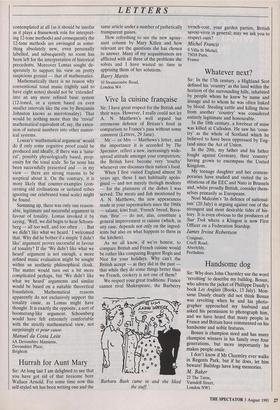Twelve-tone letter
Sir: In 'Down with dodecaphony' (Music, 6 July) Herbert Lomas aimed at producing some sort of evidence for what has been presented as a 'natural' rejection of dode- caphony, particularly that of Schoenberg. Let me first say that I enjoyed the article. In this as in other matters (alas politics included!) greyish views are the norm (and the unbearable hidden enemy), but Lomas succeeded in remaking the vigorous con- troversy of the second quarter of this century.
Regrettably though, Lomas's argument is a failure in that the presumed evidence is nothing but counterproductive reasoning. His arguments are mixed up, technicalities alongside ad hominem objections and in- effective at the utmost. Dodecaphony is restricted to Schoenberg's, serialism isn't
LETTERS
contemplated at all (as it should be insofar as it plays a framework role for interpret- ing 12-tone methods) and consequently the 12-tone methods are envisaged as some- thing absolutely new, even personally labelled, and subsequently no room has been left for the interpretation of historical precedents. Moreover Lomas sought de- sperately to support his view on pretty suspicious ground — that of mathematics.
Mathematically there is no reason why conventional tonal music (rightly said to have eight notes) should not be 'extended' into an any more refined basic system (12-toned, or a system based on even smaller intervals like the one by Benjamin Johnston knows as microtonality). That would be nothing more than the 'trivial' mathematical equivalent of, say, the exten- sion of natural numbers into other numer- ical systems.
Lomas's 'mathematical argument' would do if only some cognitive proof could be produced and ideally, if there was a 'natu- ral', possibly physiologically based, prop- ensity for the tonal scale. So far none has been successfully presented and — in my view — there are strong reasons to be sceptical about it. On the contrary, it is more likely that counter-examples (con- cerning old civilisations or isolated tribes ignoring our celebrated tonal scale) might be found.
Summing up, there was only one reason- able, legitimate and successful argument in favour of tonality. Lomas invoked it by saying, 'Well, we did begin to hear Schoen- berg — all too well, and too often . . . But we didn't like what we heard.' I welcomed that. Why did he bother if a simple didn't like' argument proves successful in favour of tonality? If the 'We didn't like what we heard' argument is not enough, a more refined music evaluation might be sought within an aesthetic philosophical cloak. The matter would turn out a bit more complicated perhaps, but 'We didn't like what we heard' arguments and similar would be based on a suitable theoretical foundation. Mathematical reasons apparently do not exclusively support the tonality cause, as Lomas might have thought. It is exactly the opposite, a sort of boomerang-like argument. Schoenberg would have felt extremely comfortable with the strictly mathematical view, not surprisingly et pour cause.
Manuel da Costa Leite 4A Devonshire Mansions, Devonshire Place,
Brighton



















































 Previous page
Previous page